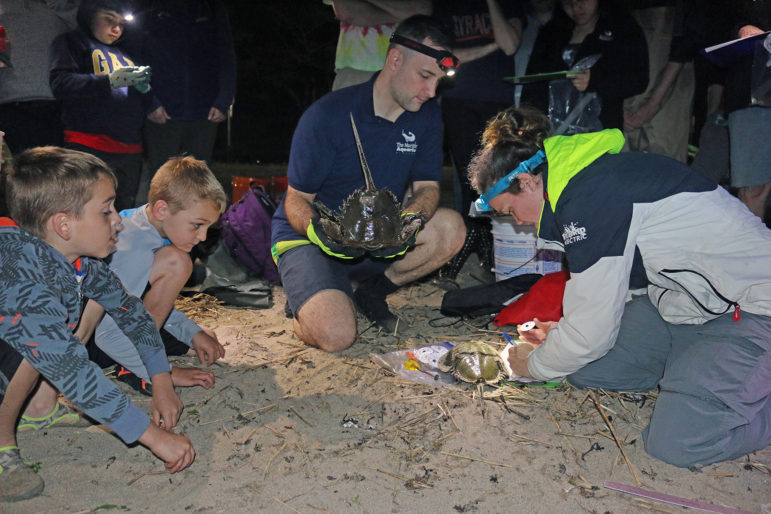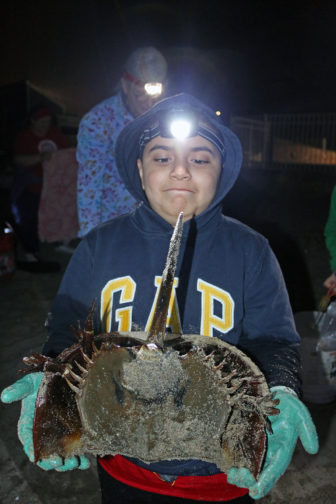A beach mating ritual that is millions of years old is about to occur again on Connecticut’s shorelines, and the Maritime Aquarium at Norwalk needs help documenting it.
— an announcement from the Maritime Aquarium
Volunteers are needed this spring to help the Aquarium tag horseshoe crabs when the unique creatures come out of Long Island Sound to spawn in the sand.
This mass event is a bonanza time to gather data for an ongoing horseshoe-crab census — so much so that help is needed from “citizen scientists.”

Photo from the Maritime Aquarium
Volunteers collect data about a horseshoe crab during a late-night horseshoe crab tagging session last year at Calf Pasture Beach.
“These tagging trainings reach capacity every spring, which thrills and amuses us,” said Aquarium spokesman Dave Sigworth. “Horseshoe crabs are hardly cute and cuddly. But a lot of people find it fun to go mucking around the beach in the middle of the night with us — all on the crabs’ behalf.
“We think much of the interest is that it’s a memorable citizen-science activity for parents and kids to do together, especially for kids curious about a career in marine biology.”
If You’re Going …
Photo from the Maritime Aquarium
A young volunteer holds a horseshoe crab ready to be tagged during a late-night session last year at Calf Pasture Beach
- To help out, new volunteers must attend one of two training sessions at The Maritime Aquarium: from 6 to 7 p.m. on either Thurs., May 2 or Tues., May 7.
- They’ll learn about the natural history of horseshoe crabs, about the census, and how to harmlessly tag the crabs.
- The training is free but a $5 donation per family to the Aquarium’s conservation efforts will be welcomed.
- To sign up or for more details about the trainings and taggings, go online, here.
- If you’ve helped tag horseshoe crabs before, you don’t need to attend a training. But please sign up for one of the tagging sessions at Calf Pasture: (203) 852-0700, ext. 2281, or e-mail BCervero@MaritimeAquarium.org.
- Volunteers should be in 10th grade or older. Younger children can assist if working with a parent, teacher or guardian. (If you’ve helped tag crabs before, you don’t have to attend the trainings. But please register for the crab taggings.)
- Volunteers must be able to be out after midnight for the crab-tagging sessions at Calf Pasture Beach in Norwalk on select nights in May and June.
The taggings are part of The Maritime Aquarium’s participation in an ongoing census of horseshoe crabs in the Sound being led by Dr. Jennifer Mattei of Sacred Heart University in Fairfield.
Monitoring the population of this ancient species is important because horseshoe crab eggs are a critical food source for migrating shorebirds. Fewer horseshoe crabs — and thus fewer horseshoe crab eggs — would have a ripple effect through the environment.

Photo from the Maritime Aquarium
Bridget Cervero (right), manager of citizen-science programs at The Maritime Aquarium at Norwalk, and Dr. Dave Hudson (center), the Aquarium’s staff research scientist, tag horseshoe crabs during a late-night session last year at Calf Pasture Beach.
Survivors from the Paleozoic Era — and looking every bit the part — horseshoe crabs are commercially harvested for bait and for use in the pharmaceutical industry. (A derivative from the crabs’ blood is used in medical testing. Crabs are returned to the water after their blood is drawn, but not all crabs survive.)
The Atlantic States Marine Fisheries Commission has established quotas on how many crabs can be harvested from each state. In Connecticut, the Department of Energy & Environmental Protection set limits on when, where and how the crabs can be harvested, in an effort to stabilize and restore the population.


